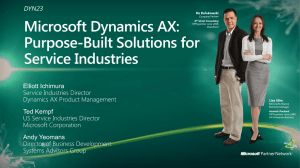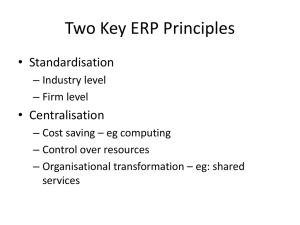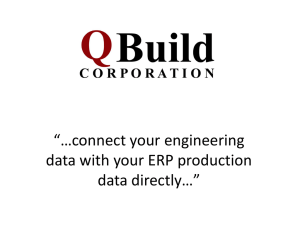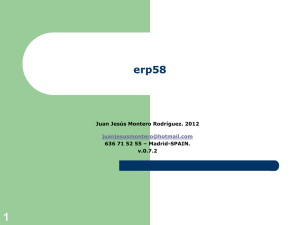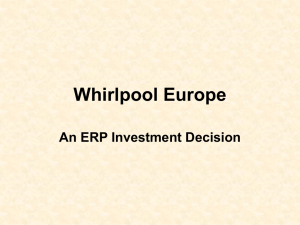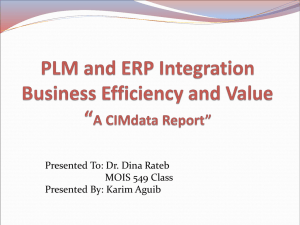BSNL ERP Project
advertisement
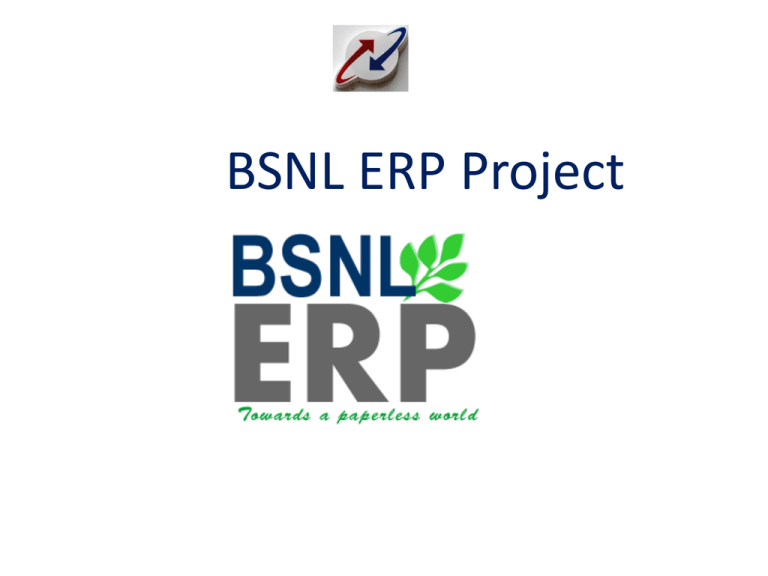
BSNL ERP Project Training Coverage Project Overview Navigating SAP ERP OVERVIEW & NAVGATION What is ERP? ERP OVERVIEW & NAVGATION What is ERP? E Enterprise R Resource P Planning BSNL 1 2 3 4 Money Men Material Machines Optimum utilisation ERP OVERVIEW & NAVGATION ERP - Definition Enterprise Resource Planning: “Software solution that addresses the Enterprise needs, taking a process view of the overall organization to meet the goals, by tightly integrating all functions under a common software platform” ERP OVERVIEW & NAVGATION Why ERP? • For Management – To know what is happening in the company. • One solution for better Management. • To achieve cost control & low working capital • To avoid the geographical gaps. • To satisfy the customers with high expectations. • To be Competitive. ERP OVERVIEW & NAVGATION Key Benefits of ERP • Real time data is available from a centralized data base. • Integration of Business Processes. • Seamless flow of information. • Standardization of processes across all Locations. • Improved Operational Efficiency. • Faster Consolidation at Head office for statutory reporting. ERP OVERVIEW & NAVGATION Implementation in BSNL • PO placed on M/s HCL Infosystems. • BPR (Business Process Re-Engineering) by M/s Ernst & Young and M/s HCL. • ERP Software by M/s SAP India. • Main Data Centre at Hyderabad & Disaster Recovery at Kolkata. • BSNL has purchased 40 thousand Licenses ERP OVERVIEW & NAVGATION Phases of Implementation • POC (Proof of Concept) Taken one unit each from various business units and implementation completed- Telecom Factory Mumbai, WTP, ALTTC, STR, Karnataka Telecom Circle, BSNL CO, Maharashtra Telecom Circle & ITPC, Pune. • ROP - Roll-Out Phase (Pan India) Phase-I NATFM Hyderabad, BBNW, WTR, Telecom Stores Kolkata, Andhra Pradesh Telecom Circle, Gujarat Telecom Circle & Punjab Telecom Circle. ERP OVERVIEW & NAVGATION Process of Implementation • As is • BPR • BBP • Realization • Cut over • Go-Live Study of the existing system. BPR [Business Process Re-engineering] is a process which explores the possibility of doing things in different ways to Improve efficiency in the operation and it involves Rethinking, re-designing BPR brings out the deficiencies of the existing setup. Compare enterprise best practices and adopted. BBP [Business Blue Print] is the activity where the existing processes and the new adopted processes are documented. The BBP (design) is implemented in the ERP system. Declare Black out period [Stop business Transactions] to migrate the Legacy data. The new system is adopted. ERP OVERVIEW & NAVGATION Major BSNL decisions for ERP • Creation of CSC : BSNL Management has decided for centralization of the payment & settlement function of the company at Corporate office and Circle office level which is a part of business process change. Drawing & Disbursing units at SSA level is to be discontinued after ERP Roll out phase. • Consolidation of Bank Accounts: BSNL Management has decided to consolidate banking operation of SSAs/DDOs through a single operation account at circle, up on migration to ERP. • Merger of Civil/Electrical Units & CMTS Wing: Accounting of Civil/Electrical Units & CMTS Wing is to be merged with respective SSAs. ERP OVERVIEW & NAVGATION About SAP and its Modules Technical Modules • ABAP • BASIS Functional Modules Finance Logistics (MM/PM/PS/S&D/REM) HR Cross-Applications • SCM (Supply Chain Management) • CRM (Customer Relationship Management) • SRM (Supplier Relationship Management) ERP OVERVIEW & NAVGATION ERP Modules in BSNL S. No. MODULE NAME S. No. MODULE NAME 1 FICO a. Finance b. Control 4 PM Plant Maintenance 2 HCM Human Capital Management 5 PS Project Systems 3 a. MM Material Management b. SRM Supplier Relationship Management 6 REM Real Estate Management 7 SD Sales & Distribution BASIS Networking, Roles & Authorisation 9 ABAP Advanced Business Application Programming 8 ERP OVERVIEW & NAVGATION Functionality of SAP Modules FICO Module FI – Financial Accounting is used for external reporting i.e. Balance sheet, Profit and Loss statements. General Ledger accounting Accounts Receivables, Accounts Payable, Asset Accounting, Bank Accounting, Consolidation, Special Purpose Ledger and Travel Management, Processing & Settlement of Temporary Advance. CO – Controlling Module is used for the internal reporting purpose. Controlling Area is the organization unit used to represents the controlling activities of Cost Center accounting, Profit Center Accounting, Product Costing, and Profitability etc. ERP OVERVIEW & NAVGATION Functionality of SAP Modules HCM Module i/c Pay Rolls Organisational Structure, Personal Actions e.g. Training, Promotion, Transfer etc. Career History. Run Regular Pay (Salary) / Off cycle Pay (Personal claims. ESS & MSS Portal (Claim items e.g. Newspaper/ Mobile/ Brief Case etc.) Medical Claims, Travel Management etc. Form 16, GPF Balance Slips / Withdrawl / Advances, Leaves, Annual Property Returns etc. ERP OVERVIEW & NAVGATION Functionality of SAP Modules MM Module Material / Service Procurement • Requisition • A.P.O. & Purchase Order • Goods Receipt / Service Verification for Vendor payment. Inventory Management ERP OVERVIEW & NAVGATION Functionality of SAP Modules SRM Module: Registration of Suppliers / Vendors & E-Tendering (Under development) ERP OVERVIEW & NAVGATION Functionality of SAP Modules PM Module: Planned & Unplanned Maintenance of various technical objects of Consumer Mobility, Broad Band, CFA, IT, Transmission (Equipment & Route), ElectroMechanical, Civil, Ducts, Fleet etc. including their Log books [Condition Monitoring] & History Sheets [Catalog] and Scrapping, Re-parenting (Shifting) etc. Notification types: Preventive, Breakdown, General, Corrective, Calibration, Shutdown, Energy Audit & Report Fault (G-1) with corresponding order types. ERP OVERVIEW & NAVGATION Functionality of SAP Modules PS Module: Execution & Monitoring of Capital Project works of various business lines e.g. CM, BB, CFA, General (Civil & Electrical) including Project Creation, its approval and Budget Allotment. External Projects Execution & Monitoring. Elements are Project, WBS (Work breakdown structure), Network, Activity, Cost Settlement and AUC (Asset under construction). ERP OVERVIEW & NAVGATION Functionality of SAP Modules REM Module: • Lease-in & Lease-out of Land and Buildings. • Lease-in & Lease-out of CMTS Towers & USO Towers (Part-A and Part-B) – Under Development. • Staff Quarter Allotment to Employees & Others. Temporary Allotment of Staff Quarters. • Booking/Allotment of Inspection Quarter, Holiday Home, Hostel, Community Centre, Auditorium etc. • Management of Contracts. • Purchase of Land and Buildings. ERP OVERVIEW & NAVGATION Functionality of SAP Modules SD Module: The processes covered are • • • • First point of sale POI (Point of Interconnect) Enterprise Business lead tracking Sale of Mobile(CM) & CFA products to CSC and Channel Partners (Franchisee/DSA/RD) Process Flow • The Inventory Data in SAP shall be updated in Sanchar-soft through an outbound interface. • The Retail sale to end customers will be made from Sanchar-soft & sale details will be updated in SAP at end of the day through an Inbound Interface. • Sale Cycle- Sales Order, Receipt of Payment, Delivery & Invoicing. ERP OVERVIEW & NAVGATION Functionality of SAP Modules BASIS Module: • Support for readiness of Networking. • Guidelines for readiness of PC for ERP access. • Roles and Authorization being done centrally • MANTIS (ERP Helpdesk). ERP OVERVIEW & NAVGATION Functionality of SAP Modules ABAP Module: • Back end Programming. • Customised development of Reports. ERP OVERVIEW & NAVGATION Development Center • Project operate under guidance of BSNL CO CIT Cell. • Development Centre established at ALTTC Ghaziabad. • BSNL officers along with System Integrator M/s HCL representatives are working in the CORE TEAM for various modules. ERP OVERVIEW & NAVGATION Regional Core Teams • Roll out phase to be operated under ITPC, Pune • Four Regional Teams formed at: North Zone - Chandigarh South Zone - Hyderabad East Zone - Kolkata West Zone - Ahemdabad ERP OVERVIEW & NAVGATION SAP Navigation Let’s Login into Double click SAP ERP OVERVIEW & NAVGATION Login Screen We shall work in QASWORK client server 400 for WE SHALL IN CLIENT training. Actual production server 500 Enter user TRG user id in 400. In PRD user id shall be our HRMS no. [Last 8 numerals leaving the first numeral (1 or 2)] Enter pass word provided for training. The default password in PRD shall be given, which need to be changed at the first login. New password to be minimum 8 ALFAA Numeric characters including one special character ERP OVERVIEW & NAVGATION SAP Window Menu Bar Standard Tool Bar Title Bar Application Tool Bar Screen Body Status Bar SAP System ID Server Insert/Overwrite Indicator ERP OVERVIEW & NAVGATION Using Navigation Area You can expand and collapse menus in the navigation area by choosing the dropdown arrows to the left of the menu items, as in the example below. To open an application in the navigation area Double-click its node ERP OVERVIEW & NAVGATION Using Navigation Area Switch to SAP menu User Menu is displayed ERP OVERVIEW & NAVGATION Using Navigation Area Click to open Nodes. ERP OVERVIEW & NAVGATION Using Navigation Area Create favorites menu by drag & drop ERP OVERVIEW & NAVGATION Business Work Place Click on this Icon ERP OVERVIEW & NAVGATION Business Work Place Click on Inbox ERP OVERVIEW & NAVGATION Business Work Place Mails in Inbox Displayed Selected mail in Inbox Displayed ERP OVERVIEW & NAVGATION Transaction Codes A transaction code can be entered in the Command field. • If the transaction code is preceded with /n then the next transaction screen opened in the current session. • If the transaction code is preceded with /o then an additional session is opened for the transaction. This means multiple sessions. ERP OVERVIEW & NAVGATION Transaction Codes – contd. To start a transaction in ECC [ERP Central Component] 6.0, there are 4 options: Position the cursor on the required transaction in the tree structure and press enter. Double-click on the required transaction in the tree structure. Position the cursor on the required transaction in the tree structure and select Edit Execute or press F2. Expand the command field and enter the transaction code. ERP OVERVIEW & NAVGATION Standard Tool Bar The Standard Toolbar contains the Command field and the standard SAP Toolbar buttons. Command Field: The Command field is used to enter transaction codes that take you directly to a system task without using menus. Button Keyboard Shortcut Description Enter Key Button Keyboard Shortcut Description Enter/Continue Ctrl + Page Up First page Ctrl + S Save to database Page Up Previous page F3 Back Page Down Next page Shift + F3 Exit System Task Ctrl + Page Down Last page F12 Cancel None Create New session Ctrl + P Print None Create shortcut on Desktop Ctrl + F Find F1 F1 Help Ctrl + G Find next Alt + F12 Customize Local Layout ERP OVERVIEW & NAVGATION SAP Easy Access Settings Users can set how SAP displays the Menu by choosing Extras Settings. Here, you can specify whether: Your favorites should appear before or after the menu. Only your favorites, and not the menu, should appear. The SAP Easy Access Graphic should appear on the right-hand side of the screen. Technical names of menu options should appear in the navigation area. ERP OVERVIEW & NAVGATION USER Settings Users can maintain their own settings by choosing System User Profile Own Data Defaults Change default printer, language, and date and decimal display formats. Parameters Allow user to create default information for frequently used fields. ERP OVERVIEW & NAVGATION Messages Messages appear either in the status bar or in a pop-up window, depending on user settings Messages starting with: “E” indicate an Error message “W” indicate a Warning message Messages not beginning with an “E” or a “W‘’ are simply Information messages Mandatory Required fields are denoted by a check mark ERP OVERVIEW & NAVGATION Major HELP Keys F1 – Information about the field F4 – Information about Data to be input ERP OVERVIEW & NAVGATION Remember • Data once stored can’t be deleted. • Good or Bad, in SAP everything is highlighted. • GIGO [Garbage Input Garbage Output] • Everything is monitored via logs ERP OVERVIEW & NAVGATION Requirements for End User Training • Administrative Requirements 1. Proper trainees are nominated. Preferably the trainees who are doing the job in the respective field for which they have been nominated to undergo training. For example, trainees for MM module should preferably be working in MM / Store units and for FICO module training, Finance & Accounts wing persons to be nominated and so on. 2. Proper number of trainees are nominated. [Maximum two per training terminal] 3. There should be at least two trainers for end user trainings, one for conducting training and another to guide trainees at their respective terminals. 4. Sufficient time is kept for hands on practice. 5. Trainers for integrated modules are available for completing end to end process during training. 6. The ERP portal should be referred for all requirements like handouts etc. 7. In case the trainer finds that some more handouts or any other requirement should be on portal, he may co-ordinate with concerned module. ERP OVERVIEW & NAVGATION Requirements for End User Training • System Requirements 1. 2. 3. 4. 5. 6. 7. 8. Suitable number of training login IDs are available (Number of training terminals x 2). Please have 5 spare IDs created for some emergent requirement. Basis Team at ALTTC Ghaziabad] may be contacted in advance to create the IDs. Contact details available on ERP Portal http://10.197.216.213 Modules Basis Contact List Networking availability / working to be ensured. All the PC / Laptops are functioning properly. SAP GUI is loaded on the PCs All the login IDs are working. On each terminal, login should be done once. Projector is working properly. ERP OVERVIEW & NAVGATION THANK YOU

